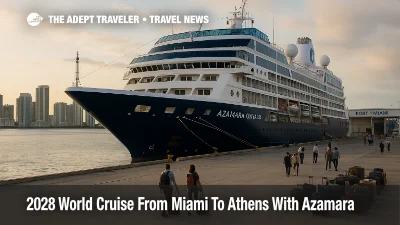Santa Marta, Columbia
Embark on an unforgettable journey and travel to Santa Marta, Columbia, a hidden gem nestled along Colombia's Caribbean coast offering a vibrant blend of stunning natural landscapes, rich cultural history, and thrilling adventures. Santa Marta, Columbia, the country's first Spanish settlement and the second oldest surviving city in South America, boasts an unparalleled seaside charm with its pristine beaches and the majestic Sierra Nevada mountain range standing as a breathtaking backdrop. Imagine strolling through the charming streets of this colonial city, with its beautiful cathedrals and vibrant markets, all the while enjoying the warmth and hospitality of the locals. As you travel to Santa Marta, nature enthusiasts will be captivated by the nearby Tayrona National Park, where lush rainforests meet crystal-clear waters, making it an idyllic spot for hiking, snorkeling, and wildlife watching. For history buffs, the city offers the Quinta de San Pedro Alejandrino, the historic estate where Simón Bolívar, the Liberator of South America, spent his final days. Moreover, the city’s bustling Rodadero area provides a lively atmosphere with its modern amenities, beachfront restaurants, and nightlife, perfect for both relaxation and excitement during your travel to Santa Marta. Whether you're seeking an adventurous escape, cultural enrichment, or a serene beach getaway, Santa Marta, Columbia, promises a diverse array of experiences that cater to every type of traveler, making it an exceptional destination worth exploring.
The History of Santa Marta, Columbia
Nestled between the crystalline waters of the Caribbean Sea and the majestic Sierra Nevada mountains, Santa Marta, Columbia, is a historical gem waiting to be discovered. As the former home of the Muisca Confederation and the Tayrona civilization, this city is imbued with a rich cultural heritage that dates back thousands of years. Founded in 1525 by Spanish conqueror Rodrigo de Bastidas, Santa Marta stands as the oldest surviving city in Colombia. If you are drawn to the deep currents of history, travel to Santa Marta, Columbia, is a journey through time and tradition that promises unforgettable discoveries.
A Glimpse into Pre-Columbian Civilization
Long before the Spanish set foot on Colombian land, Santa Marta was already a thriving cultural center. The area was originally inhabited by indigenous tribes like the Tayrona, known for their remarkable craftsmanship and advanced social systems. The Lost City, or Ciudad Perdida, is one of the most intriguing archaeological sites, located deep within the Sierra Nevada mountains. This ancient city dates back to 800 AD and is a testament to the sophistication and ingenuity of the Tayrona civilization. Visiting Santa Marta offers a unique chance to explore these ancient ruins and connect with a time long past.
The Birthplace of Columbia’s Modern History
Santa Marta, Columbia, is steeped in historical milestones that have shaped the nation. After its establishment by Rodrigo de Bastidas, the city quickly became a pivotal point for Spanish explorers, traders, and settlers. Its well-preserved colonial architecture stands as a lasting tribute to this era. landmarks such as the Cathedral of Santa Marta, the oldest church in Colombia, and the Quinta de San Pedro Alejandrino, where the liberator Simón Bolívar spent his final days, paint a vivid picture of Santa Marta’s significant role in the country's history. Traveling to Santa Marta, visitors will walk through the annals of time, experiencing the heartbeats of epochs gone by.
A Sanctuary of Natural Wonders and Historical Treasures
When you travel to Santa Marta, Columbia, you’re not just stepping into history; you’re entering a realm where natural beauty and historical richness coalesce. The city's proximity to the Tayrona National Natural Park offers visitors the dual experience of exploring lush rainforests and pristine beaches while being surrounded by historical relics. The park was once home to formidable indigenous communities, and its stunning landscapes are peppered with stone paths and terraces left behind by the Tayrona people. A visit to Santa Marta is therefore not only a cultural journey but an eco-adventure that seamlessly links past and present.
By traveling to Santa Marta, Columbia, you will be immersing yourself in a place where every corner tells a story, every monument echoes with the voices of the past, and every street hums with the vibrancy of Columbian culture. Whether you are passionate about pre-Columbian history, colonial architecture, or simply wish to savor the authenticity of a city that has continuously evolved while preserving its heritage, Santa Marta offers an experience unlike any other. Embark on a historical odyssey and let the ancient legacies of Santa Marta captivate your imagination.
The Culture of Santa Marta, Columbia
Located on the sparkling Caribbean coast, Santa Marta, Colombia, offers a cultural tapestry that is both rich and diverse, making it an irresistible destination for travelers seeking a blend of history, tradition, and modernity. Travel to Santa Marta and you will find a city that is not only the gateway to some of Colombia’s most stunning natural landscapes but also a place steeped in centuries-old cultural heritage. The city’s vibrant personality is reflected in its people, who carry a deep sense of pride and tradition, making Santa Marta a unique treasure trove of experiences.
The Melting Pot of Cultures
Santa Marta, Colombia is a melting pot of cultures, owing to its long history as a significant port and colonial center. Afro-Colombian, Indigenous, and Spanish influences converge here, creating a fascinating mosaic that is evident in the city’s music, dance, and art. The indigenous Kogi, Arhuaco, and Wiwa people who reside in the nearby Sierra Nevada de Santa Marta contribute to the region’s cultural depth. Their traditional crafts, spiritual beliefs, and sustainable ways of living are shared with intrigued visitors, offering an enriching experience that one simply must encounter when they travel to Santa Marta.
A Celebration of Music and Dance
Music and dance are integral parts of life in Santa Marta, Colombia. The city pulsates with the rhythms of cumbia, vallenato, and reggae, and you cannot help but be swept up by the joyous spirit of local festivals and celebrations. One of the most famous events is the Fiesta del Mar, a festival that transforms the city into a playground of music, dance, and maritime sports every July. Visiting Santa Marta provides a unique opportunity to witness these dynamic performances and even join in the dance, an experience that is both fun and culturally immersive. Traveling to Santa Marta during festival times is highly recommended for those wanting to fully immerse themselves in the local culture.
Historical and Architectural Treasures
The architecture of Santa Marta, Colombia is a charming representation of its historical journey. The city, founded in 1525, is the oldest in South America and boasts a stunning colonial quarter that is perfect for leisurely exploration. Iconic landmarks such as the Quinta de San Pedro Alejandrino, where the liberator Simón Bolívar spent his final days, and the Cathedral of Santa Marta, the oldest in Colombia, offer fascinating insights into the area's past. Walking through the cobblestone streets, you will find beautifully preserved colonial buildings that transport you back to a bygone era. Combining a visit to these sites with the vibrant street life and markets of Santa Marta will provide a holistic experience of the city’s cultural richness.
Travel to Santa Marta, Colombia and you will find yourself embedded in a culture that is as warm and inviting as the Caribbean sun. From the fusion of cultural influences and traditional celebrations to the stunning architecture and welcoming locals, Santa Marta offers a unique and unforgettable travel experience. So pack your bags and prepare to discover the heart and soul of Santa Marta, where every corner tells a story, and every visit creates a lasting memory.
The Food of Santa Marta, Columbia
If you are a culinary enthusiast with a penchant for trying new and exciting flavors, travel to Santa Marta offers a gastronomic adventure like no other. This coastal gem in Colombia is rich with culinary traditions that reflect its vibrant culture and diverse history. Nestled between the lush Sierra Nevada mountains and the azure Caribbean Sea, Santa Marta, Columbia presents an unparalleled dining experience that combines local ingredients, traditional techniques, and international influences. From succulent seafood to hearty street food, the dining options here are as varied and colorful as the region itself.
Exquisite Seafood Delicacies
When you travel to Santa Marta, Columbia, one of the first things you'll notice is the abundant supply of fresh seafood. Local fishermen haul in their catch daily, ensuring that the fish, shrimp, and lobster you savor are nothing short of the freshest. Don't miss the opportunity to try 'Ceviche,' a delightful dish of marinated raw fish, or 'Mojarra frita,' expertly fried fish served with coconut rice and plantains. You'll find these and more at seaside restaurants where you can dine with your toes in the sand, enjoying a magnificent sunset as you relive the taste of the ocean with every bite.
Authentic Colombian Flavors
Santa Marta, Columbia, also offers authentic traditional dishes that provide a true taste of Colombian culture. Arepas, the cornmeal cakes stuffed with cheese or meats, are a must-try and can be found at street stalls and local eateries alike. 'Bandeja Paisa' is another iconic dish, a hearty platter featuring beans, rice, plantains, chorizo, avocado, and more, promising a rich, flavorful experience. Street vendors also offer a variety of tropical fruits and juices, perfect for refreshing your palate on a warm day.
Modern Twists and International Cuisine
While the traditional dishes provide a strong foundation, the culinary scene in Santa Marta also includes modern and international elements that cater to diverse tastes. Contemporary chefs blend local ingredients with global techniques, creating innovative fusion dishes that are both unique and delectable. Sushi restaurants, Italian pizzerias, and French patisseries can all be found throughout the city, giving travelers a wide range of dining options. The eclectic mix ensures that all visitors, regardless of their culinary preferences, will find something that delights their taste buds in Santa Marta, Columbia.
Travel to Santa Marta is not just about exploring picturesque landscapes and historical sites; it's also about immersing yourself in a rich culinary tradition that tells the story of a region through its flavors. Whether you are enjoying a casual street food snack or dining in a high-end restaurant, Santa Marta, Columbia promises a memorable gastronomic journey that will leave you craving for more. Make sure this vibrant coastal city is at the top of your travel bucket list for an unforgettable culinary experience.
What to See and Do in Santa Marta, Columbia
If you're planning to travel to Santa Marta, Colombia, you're in for an unforgettable experience filled with rich history, stunning natural beauty, and vibrant culture. This coastal gem of a city has something for every kind of traveler. Here's a detailed look at the top 10 things you must do when you travel to Santa Marta, Colombia.
1. Visit Tayrona National Park
A trip to Santa Marta, Colombia wouldn't be complete without exploring Tayrona National Park. This protected area offers a perfect blend of crystal-clear beaches, lush jungles, and ancient ruins. Start your journey from the Cañaveral entrance and embark on a hike through scenic trails that lead to iconic spots like Cabo San Juan. Don’t forget to pack hiking boots and snorkeling gear; the coral reefs here are a paradise for underwater enthusiasts.
2. Explore the Historic Center
The Historic Center of Santa Marta is replete with colonial architecture, vibrant murals, and bustling plazas. Visit the 16th-century Catedral de Santa Marta, one of the oldest churches in Colombia, and Plaza de Bolívar, where you can take in the local atmosphere and street performances. This area is the heart of Santa Marta's cultural life, where you'll find many shops, cafes, and restaurants offering traditional Colombian cuisine.
3. Take a Day Trip to Minca
Nestled in the Sierra Nevada de Santa Marta mountains, Minca is a tranquil escape from the coastal heat. Only a short drive from the city, this small town offers attractions like coffee farms, waterfalls, and adventurous hiking trails. Don’t miss a tour of a local organic coffee farm, where you’ll learn about the coffee-making process from bean to cup. The cool mountain air and scenic vistas make Minca a perfect day trip destination when you travel to Santa Marta.
4. Relax at Rodadero Beach
Rodadero Beach is a popular spot for both locals and tourists, offering a long stretch of golden sand perfect for sunbathing, swimming, and water sports. Here you can rent jet skis or take a banana boat ride for an adrenaline rush. For a more laid-back experience, find a beachfront bar and sip on a freshly made coconut cocktail while enjoying the stunning sunset.
5. Discover Taganga
A short drive from Santa Marta, Taganga is a fishing village known for its relaxed vibe and excellent diving opportunities. Whether you're a novice or an experienced diver, the local dive shops offer packages that cater to all skill levels. Beyond diving, the village's beaches are perfect for kayaking and snorkeling. The local seafood restaurants serve up some of the freshest catches of the day.
6. Visit the Quinta de San Pedro Alejandrino
The Quinta de San Pedro Alejandrino is a must-visit for history buffs when they travel to Santa Marta. This 17th-century hacienda is the last residence of Simón Bolívar, the liberator of several South American countries. The estate has been turned into a museum filled with artifacts and exhibitions about Bolívar's life. The lush gardens and art gallery at Quinta de San Pedro Alejandrino make it a serene place to spend an afternoon.
7. Wander through Parque de los Novios
Located in the heart of Santa Marta, Parque de los Novios is a lively urban park surrounded by restaurants, bars, and shops. It comes alive in the evening, so it's the perfect place to go for a stroll after dinner. Street performers, live music, and bustling cafes define the atmosphere here, making it a great spot for people-watching and soaking in the local culture.
8. Trek to Ciudad Perdida
For the adventurous traveler, the trek to Ciudad Perdida (Lost City) is a once-in-a-lifetime experience. This ancient city predates Machu Picchu and is hidden deep in the Sierra Nevada de Santa Marta mountains. The multi-day trek traverses diverse landscapes, including rivers, jungles, and indigenous villages. Guided tours offer insights into the history and culture of the Tayrona people, making this challenging hike deeply rewarding.
9. Enjoy Seafood at the Local Markets
Santa Marta's coastal location means it's an excellent place for seafood lovers. Visit the local markets like the Bazurto Market for a taste of fresh, locally caught fish and seafood. Ceviche, fried fish, and other seafood delicacies are staples here. Engage with the local vendors and learn about the traditional ways of preparing these delicious dishes, ensuring an authentic culinary experience.
10. Experience Nightlife in El Rodadero
El Rodadero isn't just a beach destination; it also offers some of the best nightlife in Santa Marta. Numerous bars and nightclubs line the streets, each offering a unique atmosphere. Whether you want to dance to salsa music, enjoy a quiet drink with an ocean view, or party until the early hours, El Rodadero has something for everyone. Local bands often perform live, adding an extra layer of cultural immersion to your night out.
When you travel to Santa Marta, Colombia, these activities ensure that you'll have an enriching and diverse experience. From historical landmarks and natural wonders to vibrant nightlife and culinary delights, Santa Marta offers something for every traveler. Make sure to include these must-do activities on your itinerary for an unforgettable journey.
Why You Should Travel to Santa Marta, Columbia
Travelers are irresistibly drawn to Santa Marta, Columbia for its unique blend of natural beauty, cultural richness, and vibrant atmosphere. Nestled on the Caribbean coast, Santa Marta is a region blessed with stunning beaches, lush mountains, and the ideal climate for both relaxation and adventure. One of the key attractions is Tayrona National Natural Park, a paradise for nature enthusiasts that offers pristine beaches, diverse wildlife, and scenic jungle trails. The park's mountainous backdrop provides a perfect contrast to its golden sands, making it a favorite spot for hiking, swimming, snorkeling, and camping under the stars. Santa Marta serves not merely as a travel destination but as a gateway to untouched nature and serene landscapes.
Moreover, history buffs find much to love about Santa Marta, Columbia. Established in 1525 by Spanish Conquistadors, it’s the oldest surviving city in Colombia. Its historic center boasts beautifully preserved colonial architecture, charming plazas, and the legendary Quinta de San Pedro Alejandrino, the hacienda where Simon Bolivar spent his last days. Tourists enjoy wandering through the streets, visiting vibrant markets, and dining in quaint restaurants that serve authentic Colombian cuisine. The city’s historical importance and preservation offer a glimpse into the rich past of the region, making Santa Marta a living museum of Colombian heritage.
Beyond natural wonders and historical sites, Santa Marta is also a cultural melting pot. The local communities are a fascinating mix of indigenous, Afro-Caribbean, and European influences, resulting in a vibrant tapestry of traditions, music, and festivals. Annual events like the Fiesta del Mar celebrate the city’s maritime culture with parades, concerts, and water sports competitions, creating an energetic and inviting atmosphere. The cultural diversity adds depth to the travel experience, allowing visitors to engage more deeply with Santa Marta’s authentic spirit.
Why You Must Travel to Santa Marta
With a blend of natural splendor, historical depth, and cultural vivacity, Santa Marta, Columbia is a must-visit travel destination for anyone seeking an unforgettable experience. Whether you're an adventure seeker looking to explore the pristine jungles of Tayrona National Natural Park, a history enthusiast eager to delve into Colombia's colonial past at Quinta de San Pedro Alejandrino, or a culture aficionado ready to immerse yourself in the local traditions and festivals, Santa Marta offers something exceptional for every traveler. Its unique qualities not only captivate the senses but also enrich the soul, making every moment and interaction priceless. Traveling to Santa Marta promises not just a visit, but a vibrant, memorable journey into the heart of Colombia.
Tips & Tricks for Traveling in Santa Marta, Columbia
Planning a trip to Santa Marta, Colombia can be an exhilarating experience, but having insider knowledge can make your travel even more enjoyable and stress-free. Here are ten tips and tricks to ensure your travel to Santa Marta is memorable and seamless.
1. Explore the Historic Center
When you travel to Santa Marta, making time to explore its Historic Center is a must. This area is brimming with colonial architecture, old churches, and colorful streets that tell the story of the city’s rich past. Walk along Carrera 5 to find artisanal shops, and cafes. Don't miss the Casa de la Aduana, now the Museum of the Tayrona, to get an insightful look into the indigenous cultures of Santa Marta, Colombia.
2. Visit Tayrona National Park
One of the top attractions outside the city is Tayrona National Park. Just a short trip away, this national park offers some of the most stunning beaches in Colombia, coupled with lush jungle backdrops. Plan your travel to Santa Marta, Colombia in a way that gives you a full day to hike through the park and visit beaches like Cabo San Juan. Remember to carry enough water and wear comfortable hiking shoes.
3. Discover Taganga
Taganga is a quaint fishing village just a few kilometers from Santa Marta, Colombia. Known for its laid-back atmosphere and stunning sunsets, it's an ideal spot for scuba diving and snorkeling. If you want to immerse yourself in marine life, several local dive shops offer affordable packages for beginners as well as advanced divers.
4. Check Out Local Cuisine
The culinary scene in Santa Marta is worth exploring. From fresh seafood dishes to traditional Colombian fare like arepas and sancocho, the local cuisine can be a delightful surprise. Head to the Mercado Público de Santa Marta for a taste of authentic, local flavors. For a more upscale experience, try dining at one of the beachside restaurants on El Rodadero Beach.
5. Use Public Transport
Public transport in Santa Marta, Colombia is both affordable and convenient. Buses and minibuses, locally known as "colectivos", offer a cheap way to get around the city and its outskirts. If you're planning to travel extensively, consider getting a local SIM card for easier navigation and communication.
6. Embrace the Beach Life
Santa Marta boasts some of the most beautiful beaches in Colombia. El Rodadero is the most popular with tourists, while Playa Blanca offers a quieter alternative. If you prefer a more remote location, head to Playa Cristal in Tayrona National Park. Make sure to pack sunscreen, a hat, and plenty of water, as the Colombian sun can be quite intense.
7. Plan a Trek to the Lost City
If you’re up for an adventure, consider a trek to the Lost City (Ciudad Perdida). This multi-day hike through the Sierra Nevada de Santa Marta is a challenging yet rewarding experience. You'll traverse rivers, climb ancient stone steps, and explore the archaeological site of Teyuna. Book your trek through a trusted tour operator and ensure you’re physically prepared for the journey.
8. Learn Some Spanish
While many locals in Santa Marta speak some English, especially in tourist areas, knowing a bit of Spanish can go a long way. It can enrich your travel experience by enabling you to communicate more effectively with locals, order food, and ask for directions. Consider learning basic phrases or even taking a short course before you travel to Santa Marta, Colombia.
9. Experience the Nightlife
Santa Marta transforms once the sun goes down, offering a vibrant nightlife scene. Areas like Parque de los Novios are filled with bars and clubs where you can dance the night away to salsa, reggaeton, or traditional Colombian music. Be sure to also check out local live music performances to get a taste of the cultural vibe of Santa Marta, Colombia.
10. Stay Safe
Safety is paramount when you travel to Santa Marta. Although the city is generally safe for tourists, it's always wise to take precautions. Avoid walking alone at night in less crowded areas and keep an eye on your belongings. Use trusted transportation options and follow any travel advisories that may be in place. Your trip to Santa Marta, Colombia will be much more enjoyable if you remain vigilant and aware of your surroundings.
By following these practical tips, you can ensure your travel to Santa Marta is a delightful experience filled with unforgettable moments. Whether you're exploring its historic streets, diving in coastal waters, or venturing into lush jungles, Santa Marta, Colombia has something for every traveler.
Other Places You Might Like
If you adore the mesmerizing charm of Travel to Santa Marta, you will appreciate other splendid destinations that share its magnetic allure. From pristine coastlines to rich cultural heritage, Santa Marta, Columbia's essence can be found in various locales worldwide.
Cartagena, Columbia - Not far from Santa Marta, Cartagena showcases a perfect blend of colonial history and vibrant modernity. The historic Walled City brims with colonial architecture, cobblestone streets, and colorful houses reminiscent of Santa Marta's old town. Its Caribbean beaches and lively nightlife provide a delightful extension of your Travel to Santa Marta, Columbia experience.
Medellín, Colombia - Known as the "City of Eternal Spring," Medellín offers an entirely different but equally captivating Columbian experience. Travelers who appreciate Santa Marta's natural beauty will revel in Medellín's lush, mountainous landscapes and stunning botanical gardens. The city’s innovative urban projects, like the Metrocable, seamlessly integrate nature with city life, offering unique travel experiences.
Cartagena, Guatemala - For those intrigued by Santa Marta's indigenous culture and archaeological relevance, Antigua offers an impressive alternative. This UNESCO World Heritage site is a well-preserved colonial city surrounded by active volcanoes. Its historic churches, ruins, and folklore offer a rich cultural tapestry that evokes memories of Travel to Santa Marta.
Lima, Peru - The coastal beauty and cultural vibrancy of Santa Marta are mirrored in Lima. This Peruvian capital boasts a stunning juxtaposition of ancient Incan history and modern life. Lima's beaches, culinary scene, and historic districts like Barranco and Miraflores offer experiences similar to those in Santa Marta, making it an ideal destination for those who love Travel to Santa Marta, Columbia.
Manuel Antonio, Costa Rica - If the captivating beaches of Santa Marta left you wanting more, Santa Marta enthusiasts will find paradise in Manuel Antonio. Known for its national park that merges tropical rainforests with pristine beaches, it offers a tranquil yet exhilarating escape. Wildlife enthusiasts will appreciate the plethora of species, much like in the Tayrona National Park near Santa Marta.
Florianópolis, Brazil - Those who fell in love with Travel to Santa Marta’s coastal scenery will undoubtedly be charmed by Florianópolis. Known colloquially as "Floripa," this island city boasts over 42 beaches, offering plenty of options for sunbathing, surfing, and exploring. Its blend of laid-back island vibes and dynamic Brazilian culture offers a delightful contrast.
San Sebastián, Spain - Known for its picturesque beaches and vibrant culture, San Sebastián offers a European twist on the Santa Marta, Columbia experience. The coastal city's emphasis on mouth-watering cuisine, particularly its famous pintxos, combined with the scenic beauty of La Concha Beach, offers a multifaceted travel experience.
Phuket, Thailand - The idyllic island of Phuket shares Santa Marta's appeal with its stunning beaches and dynamic nightlife. From the bustling markets to serene temples, Phuket offers an exotic getaway filled with natural beauty that Santa Marta enthusiasts will adore.
Tulum, Mexico - The bohemian vibe and pristine beaches of Tulum closely mirror those of Santa Marta. Located on the Caribbean coast, Tulum combines ancient Mayan ruins with beautiful, turquoise waters and eco-chic accommodations, offering a seaside retreat that resonates with travelers who loved Travel to Santa Marta, Columbia.
Taganga, Columbia - Lastly, within close proximity to Santa Marta lies Taganga, a quaint fishing village frequently visited by those who travel to Santa Marta. Renowned for its diving spots and laid-back atmosphere, it provides a serene contrast to the bustling vibe of Santa Marta, allowing visitors to experience another side of Columbia’s coastal charm.
Venezuela Airspace Warning Disrupts Caribbean Routes

Colombia ELN Armed Strike Restricts Travel Dec 14 to 17

2027-28 Caribbean Cruises From Florida, Royal Caribbean

Venezuela Airspace Warning Reroutes Caribbean Flights

Asia Pacific Design Hotel Openings Through 2025

2028 World Cruise From Miami To Athens With Azamara

FAA Alert Cuts Brazil Venezuela Flights

Venezuela Flight Suspensions After FAA Airspace Warning

REI Teams With Intrepid For Member Adventure Trips

U.S.-Venezuela Tensions, Colombia's Role, And Travel

G Adventures 18-to-Thirtysomethings Adds 38 New Trips

Essential Power Converters for American Travelers to Mexico & South America

